|
DeVilbiss Perfume Bottles
|
By Marti DeGraaf and Toby Mack
Posted April 2015
|
 |
The DeVilbiss Manufacturing Company was founded in Toledo, Ohio, in 1888 by Dr. Allan DeVilbiss, a medical doctor specializing in nose and throat medicine. DeVilbiss pioneered a spray atomizer device to apply soothing and medicinal coatings to patientsŌĆÖ throats. DeVilbissŌĆÖ industrious and ambitious son Tom joined the company in 1905, and by 1907 convinced his father that the companyŌĆÖs spray technology would be well suited to applying perfume. This would open up a new and bigger market, since both the companyŌĆÖs medical and perfume products would be sold initially through the same drug store outlets.
|
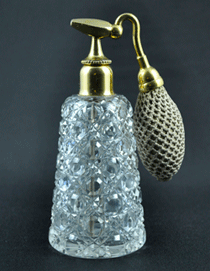
|
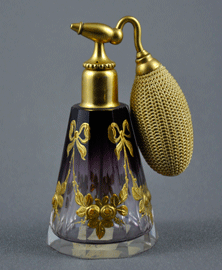
|
|
Hand cut and polished atomizer with gold plated fittings, 1914; height 5.5 inches.
|
Faceted and polished Bohemian bottle shading from amethyst to clear with gold enamel decoration, c. 1915; height 4.25 inches.
|
Realizing the importance of visual appeal of his perfume atomizers to his discriminating customers, Tom immediately set out to acquire beautifully made and decorated high-quality glass bottle blanks on which to fit DeVilbiss-made spray hardware. This took him to the glass artisans of both Bohemia and America, from whom he not only purchased supplies of cut and decorated bottles, but also recruited skilled artisans to work in his own growing decorating department in Toledo.
The popularity of perfume atomizers skyrocketed after World War I, with soldiers returning from France with perfume for sweethearts at home and with the spectacular rise of prosperity and opulence known as the ŌĆ£Roaring Twenties.ŌĆØ DeVilbiss was ready with the finest perfume atomizers on the market. The company expanded dramatically. By 1924, it had built a large new 200,000-square foot factory and by 1926 sold 1.5 million atomizer, dropper and accessory products throughout the United States, Canada and Europe.
With the onset of World War II, perfume bottle production was suspended in favor of war materiel production, but after the war, perfume atomizer sales were restarted in 1946, at first with U.S. glass suppliers and then later also with bottles from Europe and Japan. Medical and perfume atomizer production moved from Toledo to a new plant in Somerset, Penn., in 1951. Perfume atomizer production finally closed in 1968, although DeVilbiss Healthcare products are still made at the Somerset plant today.
DeVilbiss glass bottle suppliers. Throughout its history, DeVilbiss never made its own glass, although it was TomŌĆÖs dream to eventually do so. Instead, it relied on a wide range of some of the premiere glass houses throughout the U.S. and Europe. With factory records and through other means, 58 different glass bottle suppliers have been identified. This has provided collectors with a rich diversity of shapes, styles and colors to acquire. Suppliers included U.S. elegant glassmakers Cambridge, Tiffin, Imperial, Fenton, Morgantown, Central and Westmoreland. American art glass makers included Steuben, Durand, Quezal and Fry. Throughout the 1930s, bottles also came from Czechoslovakian manufacturers, prominently including Josef Riedel Glas. Also prominent in the mid-1930s were U.S.-made porcelain Lenox Beleek bottles, co-branded with both the Lenox and DeVilbiss signatures.
|
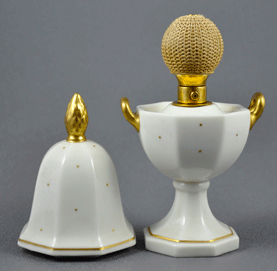
|
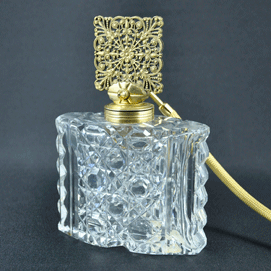
|
|
DeVilbiss Lenox Belleek China atomizer in ivory gold decorated urn, 1936; height 6.5 inches.
|
Hand cut and polished atomizer bottle from Czechoslovakia with gold finished filigree ornament, 1937; height 5.5 inches.
|
After the war, DeVilbiss resumed sourcing from European makers, including: Archimede Seguso, Toso and Moretti from Italy; Brosse and Waltersperger from France; Wittig, Hessen Glaswerke, Steiner & Vogel; and Fuger-Taube from West Germany. Post-war U.S. suppliers included Fenton, Morgantown, Viking, Owens-Illinois, Wheaton, and Carr-Lowrey. From the late ŌĆś50s, porcelain bottles came from Fairfield of Japan.
Quality, design and production excellence. Throughout its history from 1907, DeVilbissŌĆÖ hallmark was design excellence together with superb product quality. From 1924 until the late 1940s, its design and decorating department was led by the brilliant French designer Frederick Vuillemenot, a master of both the Art Nouveau and Art Deco schools.
DeVilbiss designed and patented many of their bottles and then outsourced production to their glass company suppliers. Most of the bottle decorating, including cutting, enameling and acid cutback work, was done by DeVilbiss, although some bottles were supplied with decorations applied by the glass producer, particularly those found with etchings done by the Cambridge Glass Company. Decorating techniques included both interior and exterior enameling, which afforded a great range of multi-colored designs. Gold enameling was prominent, either in pattern designs or sponge-acid encrustations.
|
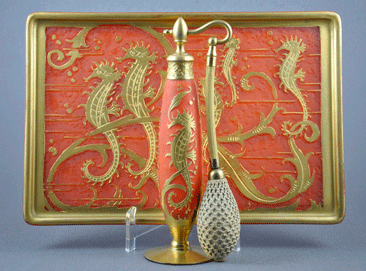
|
Perfume atomizer and dresser tray with acid cutback seahorse decoration, 1927; atomizer height 7.5 inches.
|
DeVilbiss was also known for beautifully designed and manufactured metal hardware spray or dropper collars and fittings. Brass tubing and other components were shaped and often embossed and then plated with gold, platinum, nickel, chromium or rhodium. Rubber cords, also made by DeVilbissŌĆÖ rubber products division, were covered by braiding fine silk threads. Squeeze bulbs were covered by silk nets crocheted by piece-workers operating from their Toledo-area homes through the 1920s and later imported from Europe. Luxury gift packaging, also designed and produced by DeVilbiss, included opulent presentations in beautifully decorated satin or velvet-lined cases.
Another unique DeVilbiss offering was its Unconditional Guarantee ŌĆō a rarity then and now ŌĆō which bears quoting here: ŌĆ£DeVilbiss Products are guaranteed to give complete satisfaction. Should the least irregularity develop at any time, we will be pleased to promptly repair or replace any that are returned to us, or to make any further adjustments to the entire satisfaction of the dealer or user.ŌĆØ DeVilbiss was proud of its guarantee and used it both as a marketing tool and a way to differentiate itself from its competitors.
Collecting DeVilbiss Perfume Bottles. From the beginning, DeVilbissŌĆÖ product lines were designed for all tastes and budgets, from basic atomizers to opulent (and expensive) offerings. Some of their most expensive items of the 1920s sold for the equivalent of about $1,000 in todayŌĆÖs dollars. The company worked to design an entirely new line each year but sometimes carried a particularly popular item over to a second or even third year.
The range of DeVilbiss-made items that can be found today is extensive. In the early 1920s, DeVilbiss broadened its offerings beyond perfume bottles to vanity sets, including dresser trays, powder jars, jewel boxes, vases and even candlestick holders. SmokersŌĆÖ items were offered including cigarette boxes and holders, ash trays and tobacco jars. In 1927, even salt and pepper shakers were made. Most, but not all, of the pre-1930 items were acid stamped on the bottom with the DeVilbiss logo. Afterward, most often paper labels were affixed.
|
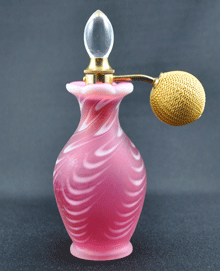
|
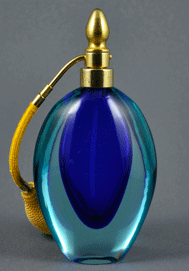
|
|
Atomizer with Fenton-supplied cranberry swirl bottle and Lucite ornament, 1953; height 6.5 inches.
|
Atomizer with Sommerso bottle by Archimede Seguso of Murano, 1965; height 7 inches.
|
As would be expected, DeVilbissŌĆÖ success attracted competitors, including Mignon, Vant Woud, Volupte, Holmes and Pyramid, along with a host of atomizer offerings from Czechoslovakia. Some can be similar in appearance to DeVilbiss and possibly confusing to the collector. In a few cases, a bottle shape was supplied by the glassmaker to more than one atomizer producer. In even fewer instances, the same bottle shape was also offered by the glass company directly to the retail market with a glass dauber but not with metal spray fittings.
Often, competitorsŌĆÖ bottle shapes and decorations were very similar to DeVilbiss designs. One of the best ways for a collector to differentiate an unsigned DeVilbiss bottle from a competitorŌĆÖs bottle is by learning to recognize DeVilbissŌĆÖ and other companiesŌĆÖ metal fitting shapes and styles. Our book, DeVilbiss Perfume Bottles and their Glass Company Suppliers, was designed to identify and highlight the numerous unique DeVilbiss fitting configurations as a guide to the collector.
Original or reprinted DeVilbiss company catalogs often do not include a complete guide to a yearŌĆÖs product line, as some products were added after printing, and others were excluded for other reasons. In addition, product line catalogs from the 1907-1920 era are scarce, and in fact the company did not produce a 1927 catalog at all, notwithstanding that yearŌĆÖs offering was stunningly beautiful from top to bottom. We were fortunate to acquire factory production records covering much of the companyŌĆÖs history, which provide an authoritative record of each yearŌĆÖs production. Some of these heretofore unpublished records are included in our book and may clear up some mysteries about who made what, and when.
We welcome all to the exploration of the wonderful world of learning and collecting DeVilbiss perfume bottles.
-------------------------------------
The authorsŌĆÖ newest book, DeVilbiss Perfume Bottles and their Glass Company Suppliers (Schiffer Publishing Ltd., 2014) is available online at www.schifferbooks.com. Marti DeGraaf and Toby Mack are avid collectors of DeVilbiss perfume bottles and other fine elegant and art glassware. Marti is a past president of the International Perfume Bottle Association, and both Marti and Toby recommend this fine organization to all with an interest in perfume bottle collecting.
|